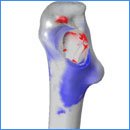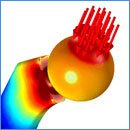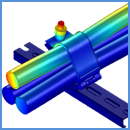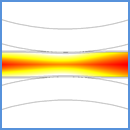Our advanced multiphysics models and simulations have been applied to a diverse range of real-world problems across various engineering and scientific fields. From complex mechanical structural systems to fluid dynamics, optics, acoustics, and bone remodelling, our simulations have helped clients refine their R&D focused efforts, helping them to optimize and improve design performance, while reducing cost and waste. Find out more by scrolling through the various examples displayed in the menu above, or by scrolling down below. You can also use the search tool (top right) to look for specific examples of our work which may not be specifically displayed on this page.

Subsea Cables & Umbilicals
Dynamic structural analysis during installation or deployment. Thermal and electromagnetics effects during use and under various working conditions and environments. Full 3D models developed, based on client supplied specifications and layups. Analysis work according to following Standards & Guidelines: ISO 13628-5:2009 (Petroleum and natural gas industries — Design and operation of subsea production systems — Part 5: Subsea umbilical).
Read more about the work we did with JDR Cables here…
Read more in COMSOL News here..
Analysis Results: Stress, strain, slip, yielding point, contact pressure, fatigue, temperature, expansion/contraction, eddy currents within armour wires.

CV Boot / Gaiter
Dynamic structural analysis and fatigue analysis assessment of contact pressures and fatigue life of a CV boot or gaiter design under operation. Material characterization of hyper-elastic materials utilised in designs. Read more about some of the work we did here…
Analysis Results: Stress, strain, contact pressure, fatigue, thermal effects

Lifting Mechanisms
The life of moving mechanical components, such as bearings and gears, are dependent on the loads they are subjected to during service. In this simulation application, the contact forces and dynamics loads between the various moving components were determined, and used to estimate service life and assess if the design met the required specifications. Read more about the work we did for CardioPercision here…
Analysis Results: Tolerance analysis, torque, stress, strain, contact pressure, fatigue

Nasal Drug Delivery
A computation fluid dynamics (CFD) coupled with particle dispersion & interactions within & on the nasal cavity membranes was developed to look at the drug delivery and deposition of an active agent in human nasal cavities. The model is used to assess, and find the optimal geometry of the device’s pressure capacity and nozzle features for specific targeted therapeutic agents within the regions of the nasal cavity to promote drug yield across the blood-brain barrier. Read more about the work we did for Alchemy Pharamtech here..
Analysis Results: Particulate (therapeutic agent/drug) distribution & deposition within nasal cavities, flow streams & pressures, optimized design flow channels

Additive Layer Manufacture (ALM)
An additive layer manufacturing (ALM) and multilayer laser solid free form fabrication (LSFF) model was used to describe the powder consolidation of titanium beads, using a high powered laser on to a work piece (substrate). ALM has drawbacks when producing large components economically out of metal alloys; these include distortion and residual stresses. Distortion, results in low production yields, while the ingress of residual stresses, not readably detectable, could result in early fatigue failure of the component during service. The model is used to find the optimal path, speed and power of the laser head in order to minimise and, or eliminate the build-up of these residual stresses during manufacture. Read more about some of the work we did for BAE Systems here…
Analysis Results: Laser path optimisation, thermal profile over time, stress-strain, and residual stresses after cooling

Total Hip Replacement (THR) Virtual Surgery
Changes in the stress and strain distribution in bone, following total hip replacement (THR) often results in bone density loss and potential fracture of the bone. A virtual THR surgical model (patient specific) was developed to assess femur implant sizes (short and long stem) and implant placement to find the optimal surgical procedure to reduce the likelihood of adverse bone remodelling in the patient. A full transient analysis was done over a 20 year period, to assess long term outcomes. Read about some of the work we did with Corin Medical here…
Analysis Results: Bone deposition & loss,, stress-strain & fracture

Pacemaker Cable Wires
An implantable cardiovascular model of pacemaker cable wires was developed to assess different material alloys, and cable wires variables, such as pitch length, and the number of micro-filaments is assessed under cyclic loading for long term fretting and fatigue damage and failure. Read more about some of the work we did for Sorin Group here…
Analysis Results: Stress-strain, fatigue, abrasion, contact pressure & slippage & wear

Orthopaedic Implant Design
Modular orthopaedic devices are a feature of total joint replacement (THR) today. If modular designs are not ideally matched, this can lead to fatigue and fretting corrosion due to the resulting micro-motion and contact stresses found at the mating surfaces of the implant assembly, during cyclical loading. This results in interface wear, which can lead to implant rejection due to wear debris induced immunological responses, or osteolysis. In this study we assess implant design changes between a modular femoral implant and quantify the resulting fretting fatigue and wear over a number of gait cycles. Read more about the work we did on fretting fatigue here…
Analysis Results: Dynamics loading characteristics, stress-strain, contact, fretting fatigue of modular designs & tolerance analysis.

Heat Exchanger
Heat Exchanger is a device used to transfer heat efficiently, from one medium to another. This automobile engine heat exchanger model was developed to assess the performance of the heat exchanger using various grades of lubricant and coolant flow rates conditions. It was used to optimize the flow channel geometric variables to maximize efficiency. Read more about the work we did for BorgWarner here…
Analysis Results: Thermal response over time, thermal fatigue, heat transfer coefficients, pressure drops, outlet temperatures & flow rates.

Spinal Implants
Total disc replacements (TDR) are spinal implants with favourable outcomes over spinal cages when it comes to restoring a patients spine mechanics and mobility. However TDRs have stringent FDA & CE requirements to overcome prior to clinical trials. This spinal model is used assess novel polymeric TDR designs (lumbar or cervical) over various wear and durability load cycle configurations (ISO 18192-1 and ASTM F2346-05). The model provided details of the fatigue and service life, and identified device failures. This model has been validated against physical test data.
Analysis Results: Stress-strain, fatigue analysis, wear, & durability, material characterisation.

Electrochemical Processes
Electroplating, electropolishing and electro-etching involve electrochemical processes which make use of ions in aqueous solutions or an electrolyte, and electrodes. The anode is where electro-polishing or electro-etching (dissolution) occurs. On the cathode; electro-plating (deposition) occurs. This model was used to explore the relationship between anode and cathode positions and connector locations to the dissolution and deposition rates. The model was also used to assess when electrical (dielectric) breakdown would occur. Read more about some of the work we have done in this area…
Analysis Results: Electrode position optimisation, evaluation of electro-deposition (or removal) vs. time, electrolyte species contractions and assessment.

Vehicle Emissions
This model looked at the release of carbon monoxide and nitrogen dioxide (NOx) exhaust fumes within a vehicle tunnel system. The model was used to assess the the tunnel ventilation under various operational conditions, and define the required minimum flow rates to ensuring adequate in-tunnel air quality and visibility thresholds.
Analysis Results: Tunnel ventilation requirements, areas of critical concentration build-up, through traffic assessments vs. halted traffic.

Bioreactors & Effluent Treatment
These models are used to assess the bubble flow of bioreactors and water treatment processes, such as dissolved air flotation (DAF) systems which purify contaminants through buoyancy effects. They are used to optimize and improve yields, for mammalian and insect cell lines in bioreactors, and dissolved air flotation process in water treatment processes. Find out more by reading our COMSOL blog post on this…
Analysis Results: Sparge profiles & flow rates, pressure profiles, bubble flow characteristics, optimisation of system, assessment of dissolved O2 & CO2 concentrations, or removal of other species.

Acetabular Cup Distortion
Changes in the stress and strain distribution in the pelvis, following total hip replacement (THR) often results in acetabular cup distortion, especially under load conditions. This pelvic model used to assess acetabular cup placement, loading and distortion. The model looked at several design scenarios, including acetabular cup material, orientations and dimensional parameters, as well as femur head variations. The cup and rim distortion was assessed in a patient specific pelvis (generated from a CT scan) under both walking and stair gait cycles.
Analysis Results: Cup loading & distortion over gait cycle (walking & stair climbing), coupled with bone remodelling results in distortion vs. time.

Short Circuiting of High Voltage Cables
When high voltage (HV) cables short circuit, large electromechanical forces can be generated, which could cause cable damage and loss of life. This electromagnetic and structural model of trefoil cables being short circuited is used to assess the type and number of restraints (cleats) required to ensure that the cables remain adequately restrained and that there is no cable damage. The model has been validated against IEC 61914 tests. Find out more by reading the work we did with CMP Products on this…
Analysis Results: Cleat spacing requirements for short circuit load, frame loads, cable damage, cleat stress-strain, failure point, load on cable ladder & fixations. Thermal response.

Knee Implants
Investigate the loading behaviour of an implant or a surgical decision on the knee, such as comparing the results of an intact ideal knee to those of different partial meniscectomy virtual surgeries. Find out more by reading our publication on this…
Analysis Results: Knee mechanics, comparative studies , implant wear, contact pressure , changes in biomechanics.

Changes in Spinal Mechanics (Spina Bifida & Spondylolysis)
This study used finite element analysis to investigate the effects of a bifid arch on the biomechanics of the lumbar spine. The study found that under axial load and rotation, the maximum stresses observed in the L5 isthmus were much higher in the case of a midline defect with a bifid arch than in the intact case, indicating a lack of load sharing across the vertebral arch. This suggests that shear fatigue failure will occur much earlier in the midline defect case than in the intact case. Overall, these findings highlight the importance of understanding the effects of structural abnormalities on the biomechanics of the spine. All the finite element models and results were performed by Continuum Blue. Find out more by reading our publication on this..
Analysis Results: Spinal biomechanics comparative study, fatigue life comparison and location of early failure in vertebral arch.

Dual Polymer Injection Moulding
This project looked at the injection moulding to two polymers into a mould cavity to produce a bespoke hyper-elastic (rubber like) homogenous product design, with specific directional stress-strain characteristics. The model was fully validated against a medical implant. Find out more by reading our founder’s publication on this…
Analysis Results: Key polymer flow rates, port locations and inlet temperature profiles, as well as cavity wall temperatures to ensure ideal hyper-elastic characteristics within implant, following cooling and curing.

Locomotive Radiator Thermal & Vibration Fatigue Life
This project looked at the vibrational and thermal loads of a locomotive radiator, in order to predict the fatigue life of the design. The model included the full assembly, bolt stresses, and assessment of flow rates and coolant temperature & thus radiator temperature and thermal expansion effects on life of system.
Analysis Results: Predicted fatigue life of design, critical areas of designs weakness, thermal stresses.

Antenna Optimisation for RFID Tags
This project involved the development of a model to match the impedance of RFID tags to maximise the read range and optimisation of an antenna design, matched to the tag’s chip. Read more about this work in our COMSOL Blog post from 2014..
Analysis Results: Optimised antenna design to maximise read range & ideally match the impedance of the tag’s chip.

Thermal Bonding & Lamination of Composite Structures
This projected involved the thermal melt and bonding of bespoke composite structures (honeycomb and laminates) to ensure an ideal bond between the structures & prevent delamination during use, while improving production rates, efficiencies, while reducing failures & maintaining high Quality Control (QC).
Analysis Results: Optimised thermal roller feed rates, temperature profiles & position tolerances to ensure perfect melt flow & bonding between honeycomb structures and metal alloy laminate.

Fully Coupled Electromagnetic Brake Simulations
Continuum blue has several electromagnetic brake models, with fully coupled effects of an electromagnetic brake systems (power on/power-off). The models include the electromagnetic forces on the armature, dynamic contact pressure and braking torque depending on a flywheel mass and initial moment of inertia of a virtually coupled system. The models assess wear on both the armature and friction pads over each brake cycle and predict the thermal effects due to friction over each brake cycle. Read about some of the our electromagnetic brake model’s capabilities in this COMSOL blog post from 2014..
Analysis Results: Thermal response, predicted wear patterns on friction pad & armature, assessment of different coil & material parameters and their effect on brake performance and life.

Acoustic Attenuation through Barrier allowing Free Air Flow
In this work we worked on optimisation the acoustic attenuation of a barrier, which maximised free air flow but maximised the acoustic attenuation across a large frequency range. Read about some of the work we did with Jaguar Land Rover here..
Analysis Results: Optimisation of Helmholtz chambers/barrier for acoustic attenuation across large frequency range, while maximising free air flow
